See also
- Gastambide-Mengin monoplane
- Antoinette III
- Antoinette IV
- Antoinette V
- Antoinette VII
- Antoinette military monoplane
- Fedor Ivanovich Bylinkin, designer of a similar aircraft, 1910
Related lists List of aircraft (pre-1914)
| Antoinette VI | |
|---|---|
| General information | |
| Type | Experimental aircraft |
| Manufacturer | Antoinette |
| Designer | |
| History | |
| First flight | 1909 |
The Antoinette VI was an early French aircraft, flown in 1909. It was a development of the Antoinette IV, its major technological advance being that it was fitted with true ailerons, whereas the former aircraft had ailerons mounted as separate surfaces on the trailing edges of the wings. Nevertheless, Levavasseur was not satisfied with this innovation and later modified the aircraft to use a wing warping system similar to that fitted to the Antoinette V.
Related lists List of aircraft (pre-1914)

Antoinette was a French manufacturer of light petrol engines. Antoinette also became a pioneer-era builder of aeroplanes before World War I, most notably the record-breaking monoplanes flown by Hubert Latham and René Labouchère. Based in Puteaux, the Antoinette concern was in operation between 1903 and 1912. The company operated a flying school at Chalons for which it built one of the earliest flight simulators.

The AEG J.I was a German biplane ground attack aircraft designed and produced by the German aircraft manufacturer Allgemeine Elektricitäts-Gesellschaft. It was a mission-specific derivative of the AEG C.IV reconnaissance aircraft.
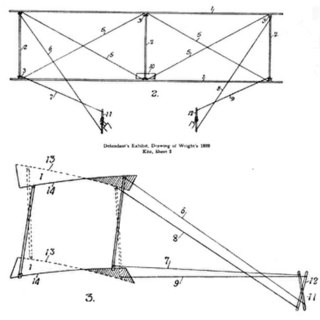
Wing warping was an early system for lateral (roll) control of a fixed-wing aircraft or kite. The technique, used and patented by the Wright brothers, consisted of a system of pulleys and cables to twist the trailing edges of the wings in opposite directions. In many respects, this approach is similar to that used to trim the performance of a paper airplane by curling the paper at the back of its wings.

The Nord Aviation 3202 was a 1950s French military trainer aircraft designed and built by Nord Aviation to meet a French Army requirement for a two-seat basic trainer, as a replacement for the biplane Stampe SV.4. Altogether, 101 examples were built, with the first flying on 17 April 1957.

The Antoinette III, originally called the Ferber IX or Aeroplane Ferber n° 9, was an early experimental aircraft flown in France. It was based on Ferdinand Ferber's previous design the Ferber n°8, and was quite unlike other Antoinette aircraft. It was renamed when Ferber became a director of the Antoinette company.

The Antoinette IV was an early French monoplane.

The Antoinette V was an early French aircraft, first flown on 20 December 1908.

The Antoinette VII was an early French aircraft, flown in 1909.

The Antoinette military monoplane, also known as the Antoinette Monobloc or the Antoinette-Latham was an early 3-seat monoplane built in France in 1911 by the Antoinette company in the hope of attracting orders from the French military. It featured a futuristic and aerodynamic design with innovative elements that were ahead of its time, including unbraced cantilever wings, an enclosed fuselage and wheel fairings, and an engine with steam cooling and direct fuel injection. However, due to an under-powered engine, it was barely able to fly and failed to attract orders.
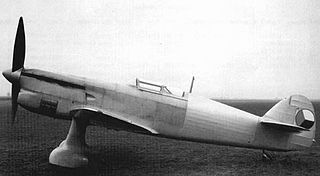
The Avia B-35 was a fighter aircraft built in Czechoslovakia shortly before World War II.

The Roe III Triplane was an early aircraft designed by the British aircraft manufacturer Avro. In configuration, it was similar to the Roe II Triplane, with a triplane tailplane and an open-top fuselage of triangular cross-section, but the Roe III was a two-seater, and featured ailerons for the first time in a Roe design. The five production machines differed from the prototype in having the ailerons fitted to the middle wing and in being powered by a Green engine in place of the prototype's JAP.

The Farman III, also known as the Henry Farman 1909 biplane, was an early French aircraft designed and built by Henry Farman in 1909. Its design was widely imitated, so much so that aircraft of similar layout were generally referred to as being of the "Farman" type.
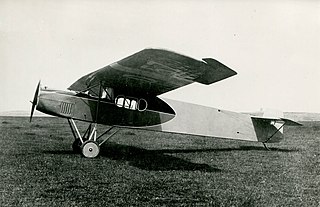
The Fokker F.II was the first of a long series of commercial aircraft from the Fokker Aircraft Company, flying in 1919. In a biplane age, it presented a distinct clean, high-wing monoplane style that sold successfully across Europe and North America during the development of commercial passenger-carrying aviation.

The Maule M-5 is an American four-seat cabin monoplane designed and built by the Maule Aircraft Company.
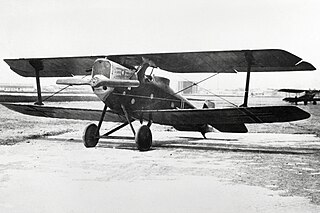
The Hannover CL.V was a biplane ground-attack aircraft built in Germany during World War I, which saw some service and additional production in Norway following the war.

The Bristol Type 72 Racer was a British racing monoplane designed by Wilfrid Thomas Reid and built by the Bristol Aeroplane Company at Filton, England.
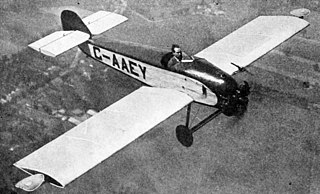
The Henderson-Glenny H.S.F.II Gadfly was a British single-seat low-wing monoplane designed by K.N. Pearson and built by Glenny and Henderson Limited at Byfleet, Surrey, England in 1929.

The Gastambide-Mengin monoplane was an early French experimental aircraft designed by Léon Levavasseur, and was the first aircraft built by the Antoinette company. The name came from Jules Gastambide, who financed the company, and Gabriel Mengin, the aircraft engineer.

Tha Antoinette III was a pioneer aircraft developed in France during 1908.

The pioneer era of aviation was the period of aviation history between the first successful powered flight, generally accepted to have been made by the Wright Brothers on 17 December 1903, and the outbreak of the First World War in August 1914.